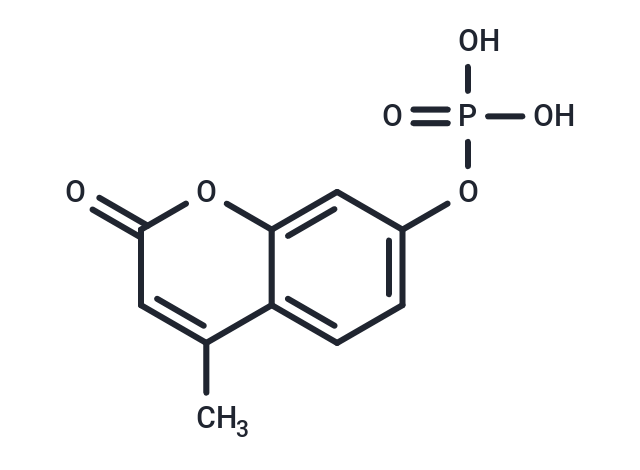Shopping Cart
Remove All Your shopping cart is currently empty
Your shopping cart is currently empty
4-Methylumbelliferyl phosphate (4-MUP) (4-MUP) is used as a fluorogenic substrate of alkaline phosphatases.

| Pack Size | Price | USA Warehouse | Global Warehouse | Quantity |
|---|---|---|---|---|
| 50 mg | $29 | In Stock | In Stock | |
| 100 mg | $41 | - | In Stock |
| Description | 4-Methylumbelliferyl phosphate (4-MUP) (4-MUP) is used as a fluorogenic substrate of alkaline phosphatases. |
| In vitro | 4-Methylumbelliferyl phosphate has a significant advantage over currently available substrates in that its useful concentration range extends to about 0.1 μM. If the concentration of 4-Methylumbelliferyl phosphate is held constant and the pH is varied, the activity of the enzyme passes through a maximum. |
| Cell Research | I. Alkaline phosphatase activity detection 1. Preparation of 4-MUP solution: Dissolve 4-MUP in an appropriate buffer, such as Tris-HCl (pH 8.0), with a concentration generally between 0.1-1 mM. 2. Add sample: Add a sample containing alkaline phosphatase (such as serum or cell lysate) to the 4-MUP solution. Adjust the final reaction volume according to the desired sensitivity. 3. Incubate the reaction system at 37°C, usually for 30 minutes to 1 hour, to allow the enzyme to dephosphorylate 4-MUP. 4. Fluorescence measurement: After incubation, measure the fluorescence of 4-methylumbelliferone by a fluorescence spectrophotometer or microplate reader, with an excitation wavelength of 360 nm and an emission wavelength of 450 nm. 5. Data analysis: The fluorescence intensity is proportional to the activity of alkaline phosphatase. By comparing with the standard curve, the enzyme activity in the sample can be quantified. II. Application in Enzyme-Linked Immunosorbent Assay (ELISA) 1. Plate coating: Coat the antigen or antibody of interest on the microplate. 2. Add alkaline phosphatase-labeled antibody: Add the antibody or enzyme-labeled probe linked to alkaline phosphatase. 3. Add substrate: Add 4-MUP substrate after washing. 4. Fluorescence detection: After incubation, measure the fluorescence signal using a microplate reader or fluorescence plate reader with an excitation wavelength of 360 nm and an emission wavelength of 450 nm. 5. Result interpretation: Quantify the amount of antigen or antibody based on the fluorescence intensity. III. Alkaline phosphatase detection in cell culture 1. Cell treatment: Culture cells in appropriate culture medium and treat as needed. 2. Add 4-MUP: Add 4-MUP solution to the cell culture medium. 3. Fluorescence monitoring: After incubation, use a fluorescence microscope or microplate reader for fluorescence measurement. 4. Quantitative analysis: Quantify enzyme activity by fluorescence intensity to evaluate changes in alkaline phosphatase during treatment or differentiation. IV. Alkaline phosphatase detection in tissue sections 1. Tissue section preparation: Prepare tissue sections using conventional histological methods. 2. Add 4-MUP: Soak the sections in 4-MUP solution, usually incubated at 37°C. 3. Fluorescence microscopy observation: After incubation, use a fluorescence microscope to observe the fluorescence signal. 5. Analysis: Evaluate the activity of alkaline phosphatase by observing the fluorescence distribution and intensity in the tissue. |
| Synonyms | 4-MUP |
| Molecular Weight | 256.15 |
| Formula | C10H9O6P |
| Cas No. | 3368-04-5 |
| Smiles | Cc1cc(=O)oc2cc(OP(O)(O)=O)ccc12 |
| Relative Density. | 1.583 g/cm3 (Predicted) |
| Color | Red |
| Appearance | Solid |
| Storage | keep away from direct sunlight,store at low temperature | Powder: -20°C for 3 years | In solvent: -80°C for 1 year | Shipping with blue ice/Shipping at ambient temperature. | ||||||||||||||||||||||||||||||
| Solubility Information | H2O: 20 mg/mL (78.08 mM), Sonication is recommended. | ||||||||||||||||||||||||||||||
Solution Preparation Table | |||||||||||||||||||||||||||||||
H2O
| |||||||||||||||||||||||||||||||
| Size | Quantity | Unit Price | Amount | Operation |
|---|

Copyright © 2015-2025 TargetMol Chemicals Inc. All Rights Reserved.